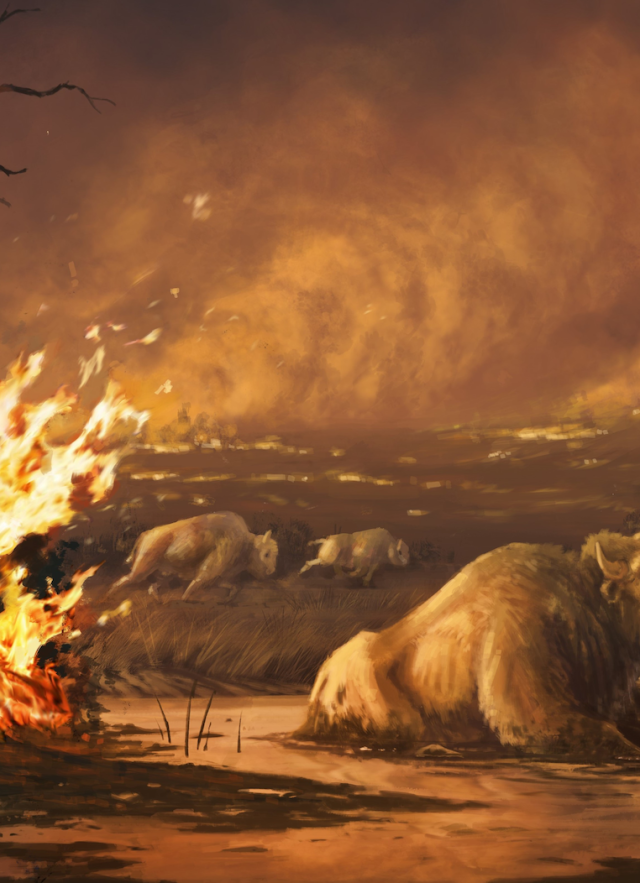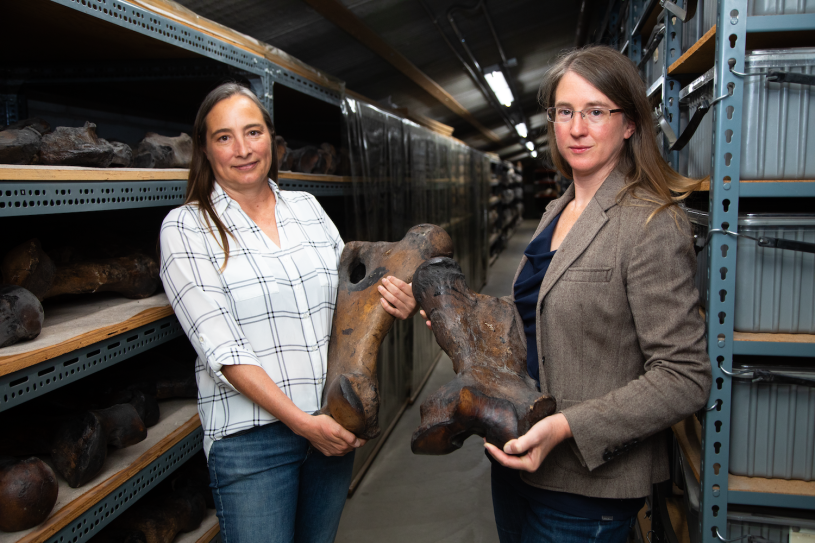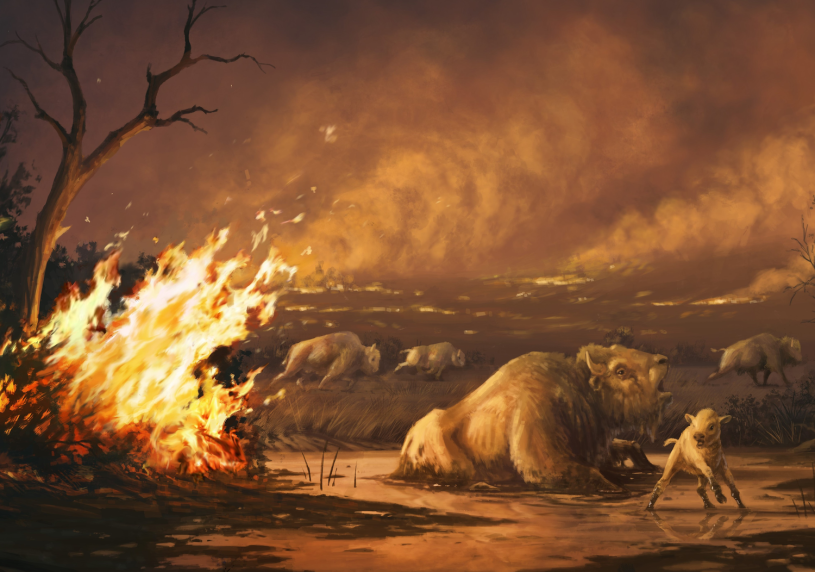Los Angeles, CA (August 17, 2023) — Large-scale wildfires, possibly started by humans, in an ecosystem made fire-prone by climate change caused the disappearance of saber-toothed cats, dire wolves, and other large mammals in southern California nearly 13,000 years ago, according to a new study by researchers at La Brea Tar Pits.
Published in the journal Science, the peer-reviewed study breaks new ground in a decades-long scientific debate over what triggered the Earth’s last major extinction event. Supported by the precise dating of fossils preserved at La Brea Tar Pits, the research advances our understanding of the dynamics between dramatic environmental change, human population growth, wildfire activity, and the abrupt disappearance of Ice Age megafauna.
“Time series modeling implicates large-scale fires as the primary cause of the extirpations,” the researchers wrote. “We argue that the catalyst of this (ecological) state shift appears to have been mounting human impacts in a drying, warming, and increasingly fire-prone ecosystem.”
They added: “This event parallels processes occurring in Mediterranean-type ecosystems today.”
“The significance of this research will resonate for decades well beyond the scientific field,” said Dr. Lori Bettison-Varga, President and Director of the Natural History Museums of Los Angeles County. “La Brea Tar Pits is the only place on Earth that has the fossil record necessary to examine the last significant climate change event in this way. The site’s collection of millions of Ice Age plant and animal fossils provides a unique opportunity to study the intersecting impacts of environmental change and human activities, which is crucial today as we think about how we can best preserve species and protect human life and property.”
The museum at La Brea Tar Pits holds the world’s largest collection of fossils from the Ice Age and has been central to the study of animal and plant life at the end of the Pleistocene epoch for more than a century.
Its naturally occurring asphalt pools entrapped and preserved the bones of thousands of individual animals representing dozens of megafaunal species over the last 60,000 years, enabling scientists to determine when different species disappeared from the ecosystem and why.
“The vast collection of Ice Age fossils in Los Angeles opens a unique window on the timing and dynamics of large mammal extinction in Southern California. Going into the carbon dating effort, the team was not prepared for how starkly our data would depict this story, nor for how profound the implications would be," said Robin O'Keefe, Professor, Biological Sciences at Marshall University and lead author. "There are 19 authors on this paper, and without the contribution of every one of them, the study would not have succeeded. And, without the ample numbers of many extinct species available at La Brea Tar Pits, we would not have had the statistical power to pose the kinds of questions we ask, nor to answer them with the precision and rigor necessary to tell this grave and poignant story.”
Using a method developed specifically for dating fossils preserved in asphalt, the research team obtained new radiocarbon dates on 169 fossils from eight large mammal species, including saber-toothed cats, dire wolves, American lions, ground sloths, extinct horses and bison, camels, and coyotes. They compared those findings to regional pollen and charcoal records and continent-wide data on human and large mammal populations to develop “the first statistical modeling of extinction causality in southern California,” the paper said. The models produced the most detailed chronology to date, showing the relationship between climate and vegetation change, fire activity, human demographics, and megafauna extinctions.
“The problem with understanding this event, which was the biggest extinction since the dinosaur age, had been that the Pleistocene fossil record was too sparse to determine exactly when and why most big Ice Age mammals disappeared,” said co-author Dr. Emily Lindsey, Associate Curator and Excavation Site Director at La Brea Tar Pits. “With new technology and new research, we have been able to connect, for the first time, a dramatic increase in human population in North America to an incredibly intense period of fires and the interval when the megafauna disappeared from our region.”
La Brea Tar Pits fossils showed that all megafauna species dated other than the coyotes were extinct by 12,900 years ago, before a sudden cold snap known as the Younger Dryas, which has often been invoked as a potential cause of the extinctions. The findings also rule out a hypothetical comet impact that some scientists had proposed as a cause of both the Younger Dryas and the extinctions, as well as overhunting by the hunter-gatherer Clovis culture, which largely post-dated the La Brea megafauna disappearance.
Instead, the study laid out a disastrous chain of ecological events, reconstructed from climate, vegetation, and fire records preserved in the sediments of nearby Lake Elsinore. It started with the gradual warming and drying of the landscape and a simultaneous decline in forest-adapted large herbivores over 2,000 years, as Earth emerged from the last Ice Age and glaciers receded. Then, just as human populations began to sharply increase in North America, the ecosystem underwent a dramatic change: temperatures rose rapidly, a 200-year-long drought parched the landscape, and massive wildfires transformed plant communities. Within 300 years, all the Ice Age giants at La Brea were gone, and California’s modern, fire-adapted chaparral ecosystem had appeared.
“This is the first time that we’ve been able to link specific changes in the climate and vegetation to specific changes in megafaunal populations,” says co-author Dr. Regan Dunn, a paleobotanist and Interim Assistant Deputy Director and Assistant Curator at La Brea Tar Pits. “The research shows that rapid warming and drying paved the way for a dramatic ecosystem shift from a woodland environment to a drier system that human-sparked fires transformed into the chaparral ecosystems we know today.”
Climate change made Southern California prone to fire, but the researchers’ models found that sharp growth in the human population had the strongest correlation with the surge in fire activity during that 300-year period. Charcoal accumulation rates, which indicate fires, were low before humans arrived, yet around 13,200 years ago, the study said, “charcoal accumulation rates suddenly increased thirty-fold” to levels that were unprecedented in records spanning 33,000 years.
“The model supports the inference of a potential positive feedback loop in which rising human populations caused enhanced fire activity both indirectly, by depressing herbivore numbers (resulting in increased fuel loads) and through increasing ignition,” the researchers wrote.
Understanding the relationship between environmental change and human activity is equally important to current-day challenges, the study said. It noted that temperatures in Southern California have risen faster in the last century than they did during the late Pleistocene. Land area burned by wildfire in the western U.S. has increased four-fold in the past 20 years, and this pattern is only predicted to worsen in coming years.
“The conditions that led to the terminal-Pleistocene state shift in southern California are recurring today in the western USA and in numerous other ecosystems worldwide,” the researchers wrote. “Understanding the interplay of climatic and anthropogenic changes in driving this past extinction event may be helpful in mitigating future biodiversity loss in the face of similar pressures.”
Pre–Younger Dryas megafaunal extirpation at Rancho La Brea linked to fire-driven state was authored by F. Robin O’Keefe, Regan E. Dunn, Elic M. Weitzel, Michael R. Waters, Lisa N. Martinez, Wendy J. Binder, John R. Southon, Joshua E. Cohen, Julie A. Meachen, Larisa R. G. DeSantis,Matthew E. Kirby, Elena Ghezzo, Joan B. Coltrain, Benjamin T. Fuller, Aisling B. Farrell, Gary T. Takeuchi, Glen MacDonald, Edward B. Davis, and Emily L. Lindsey and was published in Science on August 17, 2023.
About La Brea Tar Pits
The asphalt seeps at La Brea Tar Pits are the only consistently active and urban Ice Age excavation site in the world. This makes the site a unique window into active science—where fossils are discovered, prepared, researched, and displayed in one place. Outside, visitors can watch excavators unearth fossils of Ice Age plants and animals that were trapped and preserved in the seeps. Inside the museum, scientists and volunteers clean, repair, and identify those fossils. The best specimens are displayed and available for research: from extraordinary saber-toothed cats, giant sloths, dire wolves, mammoths, and mastodons—to microfossils of small animals and plants. These collections constitute an unparalleled resource for understanding environmental change in Los Angeles, and the planet, during the last 50,000 years of Earth’s history.
About the Natural History Museums of Los Angeles County
The Natural History Museums of Los Angeles County (NHMLAC) include the Natural History Museum in Exposition Park, La Brea Tar Pits in Hancock Park, and the William S. Hart Museum in Newhall. They operate under the collective vision to inspire wonder, discovery, and responsibility for our natural and cultural worlds. The museums hold one of the world’s most extensive and valuable collections of natural and cultural history—more than 35 million objects. Using these collections for groundbreaking scientific and historical research, the museums also incorporate them into on- and offsite nature and culture exploration in L.A. neighborhoods, and a slate of community science programs—creating indoor-outdoor visitor experiences that explore the past, present, and future. Visit NHMLAC.ORG for adventure, education, and entertainment opportunities.
Media Contacts:
Amy Hood
213-763-3532
ahood@nhm.org
Tyler Hayden
213-763-3508
thayden@nhm.org


